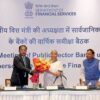Arun Jain, chairman of Intellect Design Arena, has not only made a mark as a successful entrepreneur, but also as a fundamental thinker. Where so many entrepreneurs made easy money selling software services, he actually sold off his IT services business to concentrate on products. Manoj Agrawal interviewed him to comprehend his mindset, his journey and the outcome. Edited excerpts
Manoj Agrawal: During my visit of the facility, I saw a fundamentally new approach to solving problems. You are doing 2 things here. First, is you’re not taking the problem as is given to you by the customer, but you are understanding it in greater depth. Second, you’re not applying a template solution. You’re actually designing a meaningful solution. This is not what the IT service industry has done for nearly 50 years and made easy money. How did you come to this new thinking approach?

Arun Jain, chairman of Intellect Design Arena
Arun Jain: Since we are focusing on the banking and financial sector, I will restrict myself strictly to that sector more than other industries. This is amongst the sectors that adopted technology early in the game – it has been there since the 1960s. More the technology is implemented, more the complexity is added. So, older the corporation is, higher the number of software people. Something is fundamentally wrong somewhere, which is leading to patchwork. This complexity hit my mind during my days at Polaris when Citibank was my customer, and we had around 3500 employees at Polaris working for Citibank alone. Polaris was just one of the vendors, TCS had around 6000. So, we are talking of really big numbers. Fundamentally, I asked myself the question – if I have to start a bank and the bank has to offer some ‘n’number of services to its customers, then why should there be so much of complexity sitting in the system!
This complexity has 5 dimensions: multi-generational technologies, multiple products, multiple CEOs, as they keep changing, each CEO want the same solution in a new bottle. Then there is complexity of globalization which has happened. Regulatory complexity comes in whenever you are adding new product lines, along with globalization. So, in this multi-complexity scenario, the typical bank does not have the time to think about it and say: let’s think for 3 months and relook at a customer centric approach to design. They never really do customer centric thinking; they do process centric thinking – optimize call-center, optimize robotic process automation, etc.
First of all, you need to know whether that process is required or not. It is easy to automate what is previously there, without challenging the fundamental need of that. We have so many assumptions and biases that we don’t challenge. That’s how I spent so many years at Polaris. I found this is fundamentally wrong and felt the need to apply some fundamental thinking. We call it design thinking, but fundamentally it is systemic thinking. So that is what started the journey sometime in 2009-10 when I took up the challenge. I started researching on the human mind, how the mind works, what are its elements, and so on, including our Jain philosophy.

Apart from religion, what other sources of learning or about mind did you study?
Carl Rogers has written about multiple intelligences, which is very good. Harvard has done a very good job in learning, and Stanford has done a very good job in Design Thinking. There are separate school of thoughts – Stanford gives design thinking, learning thought comes from Harvard and deep philosophical research comes from Oxford and Cambridge. All my learnings between 2007 and 2011 were from these sources.
My curiosity kept pushing me. Most of my Saturdays and Sundays were spent in reading books. That is when we started a movement. I realized that learning processes keeps the mind open. So, the whole program of the Unmukt came out sometime in 2010, and then I conducted this program with 2000 of our people. I conducted multiple sessions with about 100 people in each session. It was a full day program to change the thinking process. It is the thinking that makes a difference to the solution. Since the solution is the outcome of the thinking process, the workshop created a certain level of sharpness in our solutioning.
Then we started creating the framework. Around 2010-11, I realized that just the way religion needs a temple for God, we also need a beautiful physical structure for our design thinking. So, in 2011, we had set up a multi-disciplinary team of 10 people comprising an architect, an engineer, a banking domain specialist, a project manager, etc. We would sit down for 2 hours every Friday, and it took us almost 9 months to design this facility. I told my team not to have any constraints and take as much space as they want. Over a period of 9 months, we created 3-4 models and we kept iterating until we reached the final model that we have today. The final model was finalized in 2012. It took 2 years to construct this center.

I am sure you have not stopped your thinking and learning process. How long before you come up with version 2?
Our physical infrastructure has been finalized and frozen. It is said that innovation is a continuous process, till the time it becomes an algorithm. One should not tinker with it after that. Innovation creates anxiety – lot of companies say that innovation is a must, but that is true only until you reach the final product.
Take the smart phone for example. Once it was designed with screen, camera, sensors, etc, there has been no fundamental change. All the improvements are incremental. This is why we say that the last 2% is equivalentto 200%. The more we refine knowledge, the more valuable it becomes.
Do you patent your innovations to create intellectual property?
The innovations we are doing at Intellect do help us get patents. We feel happy that we have number of patents. But more patents do not automatically result in good business. What is needed is solutions to problems. Apple has far fewer patents than IBM, but it is doing much better business. So relevant solution matters more than patents.
Since the market and regulation are dynamic, your solution must not only be relevant, but also contextual. So, if you look at Kerala vs UP, the context will be different in terms of credit verification, repayment verification, etc, and such nuances should be reflected in the solution.

There are design thinking centers across the world in research institutions, academic organizations, industrial organizations, etc. Perhaps, even NGOs. Yours is mainly fintech focused. Have you done something to learn from them, by comparison or other means?
We are continuously learning from them. We have broken down design thinking into a 2-step process. First is to change the thinking at the individual level and then at the organizational level. Every corporate has an organizational level thinking, which is also called culture. Those organizations that think for themselves tend to be long lasting. If an organization merely copiesothers, it will get finished if the organization it is copying is finished. If you copy the thinking process from another organization, it will give only limited results.
Designing the thinking process is the science of design thinking. Our design center represents the theory part of design thinking. The application part is in the organization itself.

When you do the explanation of your design thinking to potential customers, they might be coming with their own design thinking concepts and models. If there are differences, then how does it work out?
What we have seen is that most of the alternative models offered are not holistic. We have a book where we have documented the 3 laws of design thinking. It also covers design definition and has stories. It includes definitions and laws of design thinking, design mind, design process, design frameworks, space, methods and tools – so there are seven blocks in all.
So now, among our customers, nobody has all the seven. Some of them talk only about process. They may be missing the definition. Even though every company will have a framework, it is not aligned. You must have design stages – you have a desirability of the solution, but that desirability itself is a mystery because the client does not know fully what they want. So we ask questions, and distil the responses and connect the blind spots and come to the algorithm. That is how we bring clarity about the solution.
Understanding our approach takes half a day or so. We explain our fundamentals of design thinking – less is more, last2% is 200%, and theory of 10 gm, 100 gm and 1000 gm, design mind, etc. We see that any limiting belief and comfort zone can be an obstruction in the design thinking, these we call the frictional forces. Conflict is also an obstructive force. So is doubt, anger, fear and ego. These 5 things obstruct the flow. Our design process is a 5-step process.

Are you applying design thinking anywhere else?
I also apply the same design thinking for rural development in our India Panchayat Forum. I wanted to test our Design Thinking outside of fintech where it has been proven with the quality of our products and their acceptance and their premium. I wanted to pick up the most difficult space to apply this – and that is rural India. Out of 1.3 billion, 900 million people live in rural India. What is the development model there – it is simply trying to copy the urban model. The village school is a copy of the city school, with the same textbooks and curriculum, even though contextually, it is different. The motivations of the students are different.
So, we started by going and observing things in different villages. Now we are working with more than several villages with different partners, and continuous learning is happening. We are organizing a 3-day workshop with 30-40 panchayat representatives, where they go through a structured approach based on our design thinking model. They will visualize their village 10 years in the future, and we help them plan a Samriddhi Yatra towards prosperity. They are not waiting for Government to deliver. I believe that the role of Government is governance.
We did 10 workshops on a pilot basis to learn what works and what doesn’t. Now we have packaged it and signed up with NIRDPR (National Institute of Rural Development and Panchayati Raj) to create a cluster development program. We are looking to have 100 clusters, each comprising of 5 panchayats. This will cover about 1000 villages.
Thank you, Arun for the insightful story. Wish you and your team great success in leveraging design thinking and making a deep impact in multiple areas.







